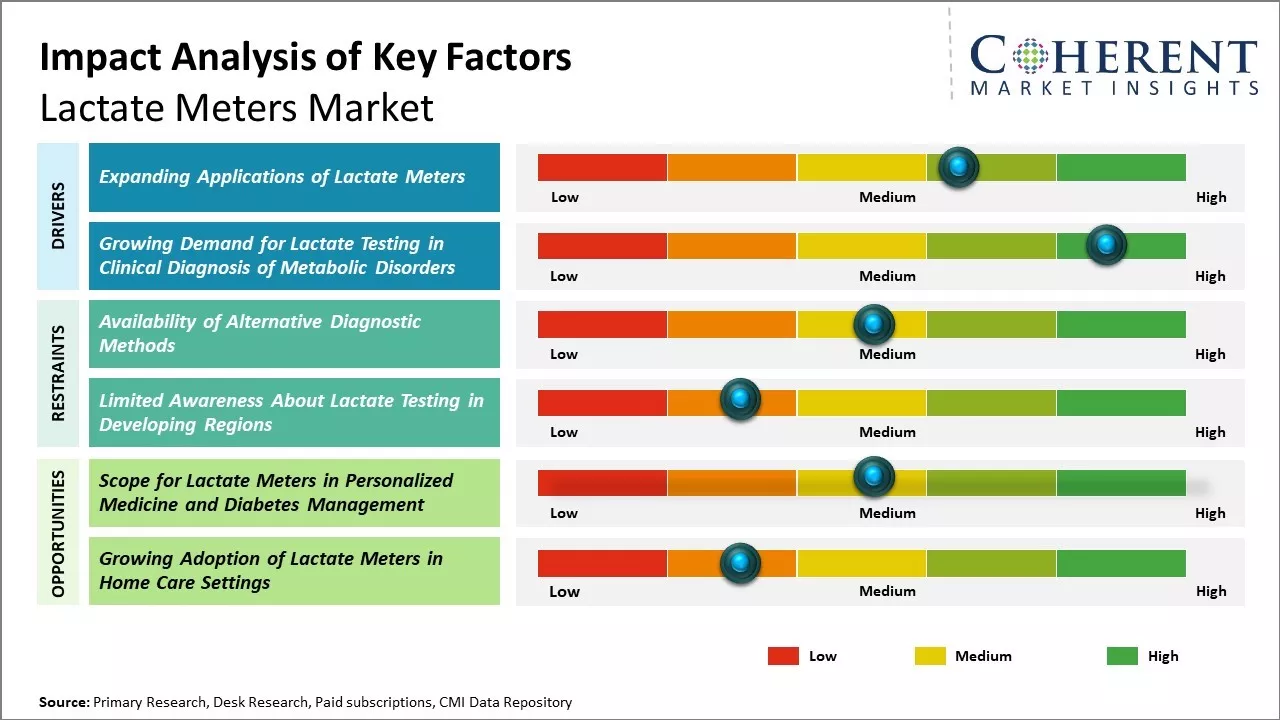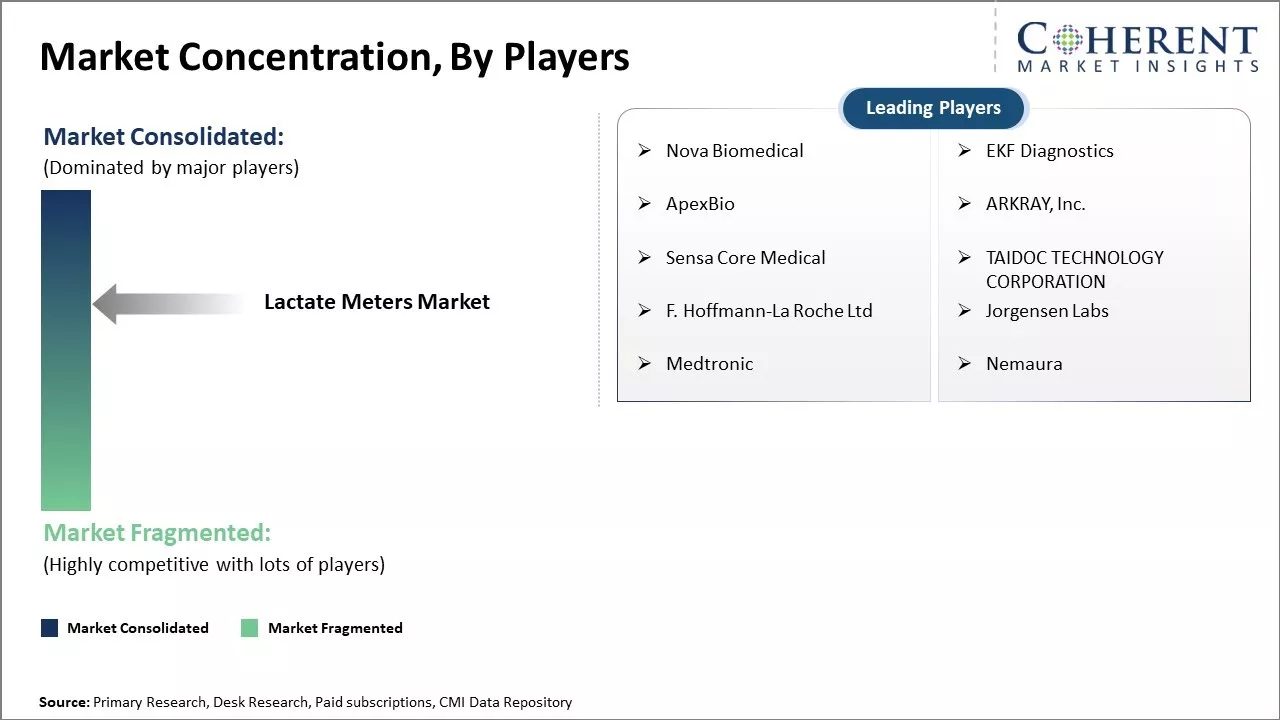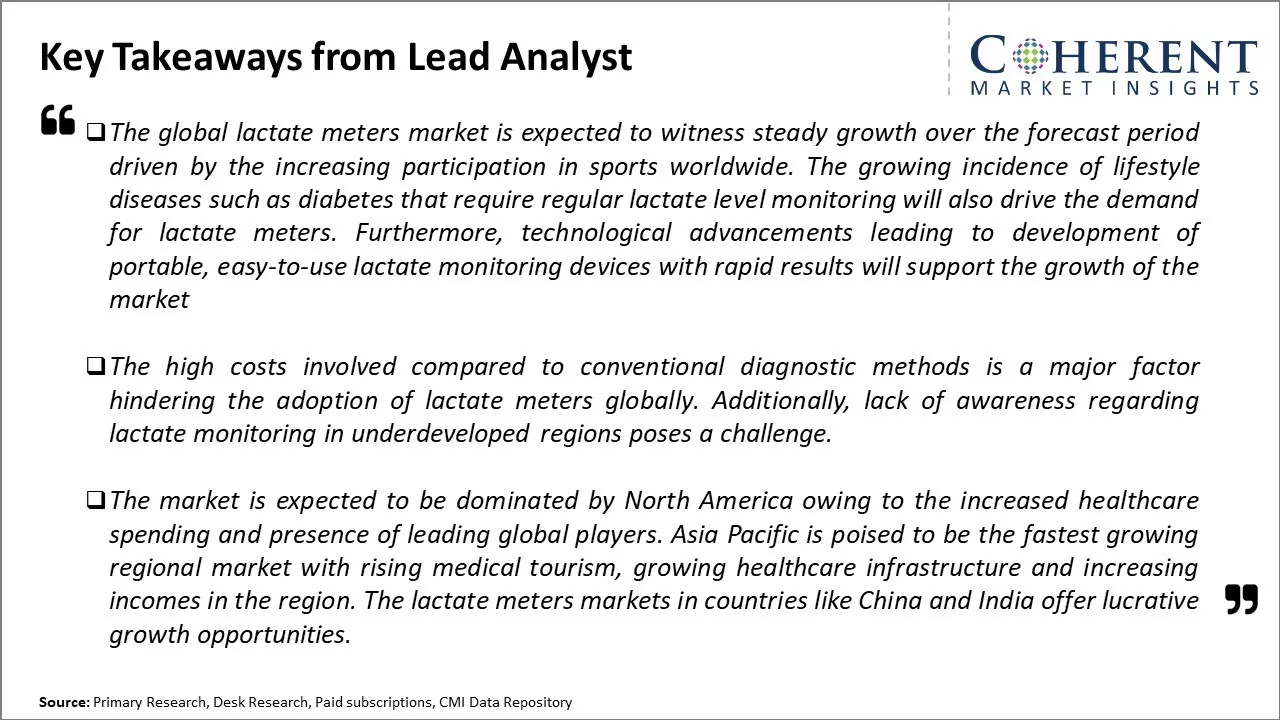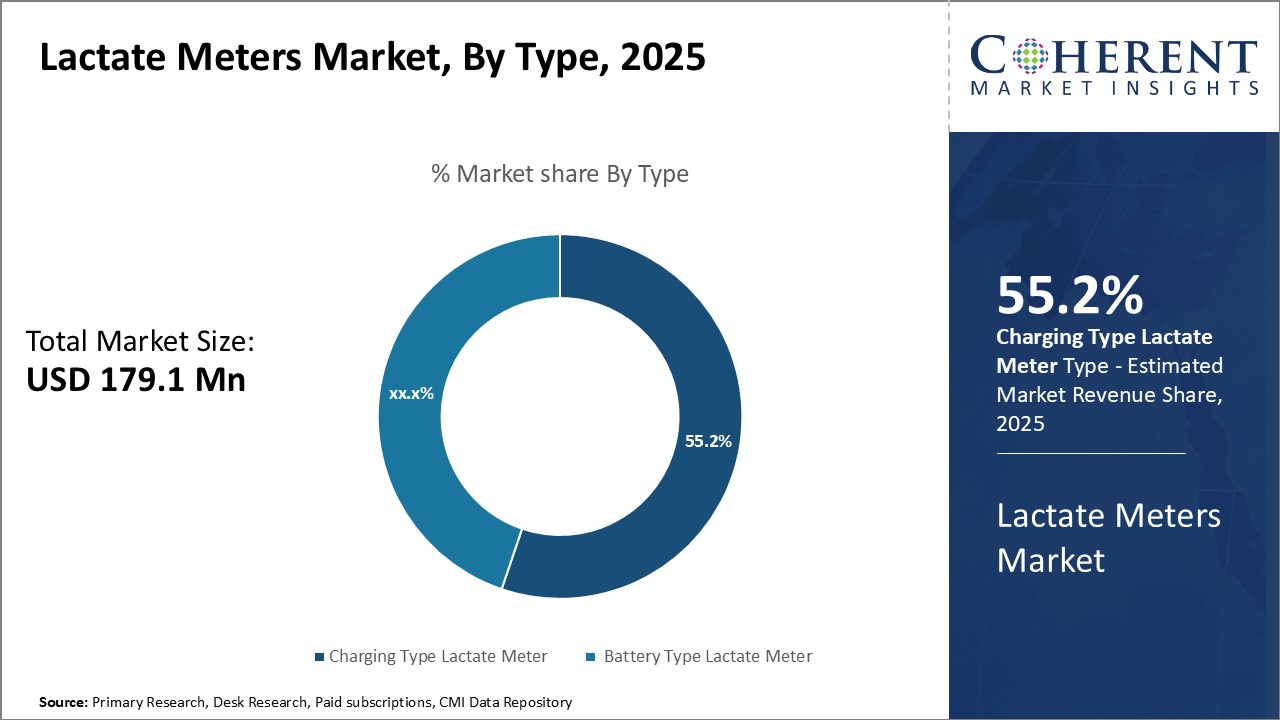Lactate Meters Market Size and Trends
Global lactate meters market is estimated to be valued at USD 179.1 Mn in 2025 and is expected to reach USD 327.6 Mn by 2032, exhibiting a compound annual growth rate (CAGR) of 9.0% from 2025 to 2032.

Discover market dynamics shaping the industry: Download Free Sample
The increasing incidences of lifestyle-related disorders, such as diabetes and cardiovascular diseases, are expected to drive the demand for lactate meters. Rising awareness regarding the importance of lactate monitoring in sports activities is also contributing to market growth. Additionally, technological advancements in lactate meters resulting in user-friendly and portable products are expanding the potential consumer base. The key players operating in this market are focused on new product launches and regulatory approvals to consolidate their market position. However, high product costs and lack of reimbursement policies in some regions may hinder the market growth.
Market Driver – Expanding Applications of Lactate Meters
The use of lactate meters has grown beyond just monitoring athletes' lactate levels during training. These portable, handheld devices are increasingly being used in healthcare settings to monitor patients' lactate levels. Elevated blood lactate levels can be an early indicator of conditions like sepsis, which if caught early can significantly improve patient outcomes. More hospitals and clinics are adding lactate meters to their arsenal of point-of-care diagnostic tools to help providers get a faster read on a patient's condition. These devices provide results quickly without needing to send samples to a central lab. This allows medical staff to begin treatment sooner if high lactate levels point to potential issues. Beyond just sepsis, lactate monitoring also aids in the treatment of illnesses like diabetes, where spikes in blood lactate can signal hyperglycemia or hypoglycemia. As healthcare moves towards more proactive, preventative models, portable devices that enhance the monitoring of at-risk patients are seeing greater uptake.
Market Concentration and Competitive Landscape

Get actionable strategies to beat competition: Download Free Sample
Growing Demand for Lactate Testing in Clinical Diagnosis of Metabolic DisordersThe global demand for lactate testing is increasing substantially owing to its crucial role in clinical diagnosis of various metabolic disorders. Lactate meters have emerged as convenient point-of-care diagnostic tools to measure lactate levels through minor blood samples. Doctors can now easily monitor lactate levels in patients suffering from conditions like diabetes, cardio-vascular diseases, respiratory illnesses, liver dysfunction, cancer, etc. during routine examinations or emergency treatments. Lactate is considered as an important biomarker or vital sign along with parameters like blood pressure, heart rate, etc. Its timely detection helps medical practitioners make quick clinical decisions, diagnose underlying metabolic causes, evaluate the severity of a disease as well as effectiveness of ongoing treatments. This has significantly boosted the adoption of lactate meters across hospitals, clinics, emergency rooms, and ambulatory surgical centers. For example, according to data from the World Health Organization (2020), metabolic disorders accounted for over 40% of global disease burden and were among the leading causes of mortality. Early screening for lactate levels is proving highly beneficial for improving health outcomes in such patients.

To learn more about this report, Download Free Sample
Market Challenge –Availability of Alternative Diagnostic MethodsThe availability of alternative diagnostic methods is significantly restraining the growth of the global lactate meters market. There are several non-invasive and low-cost diagnostic options available that can measure lactate levels without requiring a separate lactate meter device. This has reduced the adoption of lactate meters among users.
Market Opportunity – Scope for Lactate Meters in Personalized Medicine and Diabetes Management
The global lactate meters market has a great potential to grow in the area of personalized medicine and diabetes management. With increasing focus on precision and personalized healthcare, lactate meters offer an opportunity to monitor vital health parameters of patients in non-invasive way. Lactate levels in blood provide useful insights into patient's health conditions and help doctors customize treatment plans accordingly. Several clinical studies show that lactate monitoring helps doctors gain valuable information about patient's effort tolerance, exercise intensity, and recovery needs. This personalized approach has benefited athletes and people undergoing cardiac or chemotherapy treatment. It can also help diabetes patients better manage their blood glucose levels and prevent complications. As per the International Diabetes Federation, approximately 537 million adults were living with diabetes worldwide in 2021 and the number is projected to rise to 643 million by 2030. Regular lactate monitoring can empower diabetes patients to make informed lifestyle and medicine related decisions.

Discover high revenue pocket segments and roadmap to it: Download Free Sample
Insights, By Type: Portability Drives the Demand for Battery Powered Lactate MetersType segment is sub-segmented into charging type lactate meter and battery type lactate meter. The battery type lactate meter sub-segment is estimated to hold 55.2% of the market share in 2025 owing to its portability. Being powered by batteries, these meters can be easily carried anywhere and used for measuring lactate levels on the go. Their light weight and compact design makes them highly convenient to use during sports events and games. Battery type meters allow coaches and trainers to monitor player performance from the sidelines and make changes to training regimens accordingly. Their hassle-free operation without the need of external power has increased their adoption rate among individual athletes as well who can test lactate levels during practice sessions anywhere and anytime.
Insights, By Application: Sports Performance Monitoring Boosts Usage in Training Facilities
Application segment is sub-segmented into medical intervention, sports performance monitoring, and others. The sports performance monitoring sub-segment is estimated to hold 44.1% of the market share in 2025. Lactate meters are increasingly being used in gyms and training centers to assess anaerobic thresholds, monitor workout intensity, and design custom training programs for athletes. Professional coaches rely on lactate level testing to gauge athlete conditioning and prevent overtraining. Sports facilities utilize lactate meters to develop position-specific training routines, improve player endurance and optimize recovery periods. The focus on scientific training methods is driving the use of lactate testing for tracking performance enhancements over time in sports like soccer, swimming and cycling.
Insights, By End User: Clinics Lead Demand from the Healthcare Sector
End user segment is sub-segmented into hospitals & clinics, sports centers, and home care settings. The sports centers sub-segment is estimated to hold 38.7% of the market share in 2025. However, demand is also rising from the healthcare sector, especially from hospitals and clinics. Doctors employ lactate measurements to check metabolic functions, diagnose cancer, and help guide treatments. It is used as an important diagnostic marker for conditions affecting the liver, kidney, and diabetes. Besides aiding in patient care, clinics undertake lactate profiling of individuals before high-intensity exercises. This helps design safe and effective training routines accounting for individual metabolic thresholds.
Regional Insights

Need a Different Region or Segment? Download Free Sample
North America remains the dominant region in the global lactate meters market is estimated to hold 35.3% of the market share in 2025. The presence of major players from the medical device industry, such as Abbott and Nova Biomedical, has given the region an edge over others. These players have been manufacturing lactate meters for a long time and have achieved economies of scale in production. In addition, greater awareness among athletes and sports persons regarding lactate testing has driven the demand for lactate meters in the region. There is also a high focus on fitness and health monitoring in countries like the U.S., which has boosted the uptake of lactate meters for personal use. Another major factor for North America's dominance is the large number of sports academies and universities with varsity-level athletic programs. Regular lactate testing helps in optimizing the training regimes for athletes. Moreover, North American sporting events, such as marathons and triathlons, have gained widespread popularity which has led to higher sales of lactate meters. The developed healthcare infrastructure and availability of reimbursement for lactate tests conducted in hospitals and clinics have further supported the growth of the market in the region.
The Asia Pacific region has emerged as the fastest growing market for lactate meters. Factors such as rising health consciousness, growing participation in sports, and increasing expenditure on fitness tracking devices have boosted the sales of lactate meters. While China and Japan already have an established market backed by presence of leading medical device players, other developing nations in Southeast Asia are witnessing high growth on account of rising disposable income and growing middle class population. The increasing focus of international sports brands and fitness equipment manufacturers on untapped opportunities in Asia Pacific is also helping drive the adoption of high-end lactate meters.
Market Report Scope
Lactate Meters Market Report Coverage
| Report Coverage | Details | ||
|---|---|---|---|
| Base Year: | 2024 | Market Size in 2025: | USD 179.1 Mn |
| Historical Data for: | 2020 To 2024 | Forecast Period: | 2025 To 2032 |
| Forecast Period 2025 to 2032 CAGR: | 9.0% | 2032 Value Projection: | USD 327.6 Mn |
| Geographies covered: |
|
||
| Segments covered: |
|
||
| Companies covered: |
Nova Biomedical, EKF Diagnostics, ApexBio, ARKRAY, Inc., Sensa Core Medical, TAIDOC TECHNOLOGY CORPORATION, F. Hoffmann-La Roche Ltd, Jorgensen Labs, Medtronic, and Nemaura |
||
| Growth Drivers: |
|
||
| Restraints & Challenges: |
|
||
Uncover macros and micros vetted on 75+ parameters: Get instant access to report
Lactate Meters Industry News
- In April 2020, Nova Biomedical, a medical technology company, announced that it had launched Stat EMS Basic blood testing system for ambulance and emergency care in CE mark countries. Stat EMS basic measures fingerstick capillary lactate, glucose, ketone, and hemoglobin, in 6 to 40 seconds with laboratory results.
- In October 2018, EKF Diagnostics, a healthcare company, announced the launch of Lactate Scout 4, a pocket-sized lactate monitor for sports performance monitoring
*Definition: Lactate meters are portable devices used to measure the concentration of lactate in blood samples. They are essential tools in both medical diagnosis and athletic training, providing crucial information about an individual's physiological state. These meters typically involve the use of blood testing strips, which are inserted into the meter after a small blood sample is taken from the finger or earlobe. The meter then analyzes the lactate levels in the blood, providing a reading that can be used to assess an athlete's endurance levels, devise optimal training programs, and monitor progress over time.
Market Segmentation
- Type Insights (Revenue, USD Mn, 2020 - 2032)
- Charging Type Lactate Meter
- Battery Type Lactate Meter
- Application Insights (Revenue, USD Mn, 2020 - 2032)
- Medical Intervention
- Sports Performance Monitoring
- Others
- End User Insights (Revenue, USD Mn, 2020 - 2032)
- Hospitals & Clinics
- Sports Centers
- Home Care Settings
- Regional Insights (Revenue, USD Mn, 2020 - 2032)
- North America
- U.S.
- Canada
- Latin America
- Brazil
- Argentina
- Mexico
- Rest of Latin America
- Europe
- Germany
- U.K.
- Spain
- France
- Italy
- Russia
- Rest of Europe
- Asia Pacific
- China
- India
- Japan
- Australia
- South Korea
- ASEAN
- Rest of Asia Pacific
- Middle East
- GCC Countries
- Israel
- Rest of Middle East
- Africa
- South Africa
- North Africa
- Central Africa
- North America
- Key Players Insights
- Nova Biomedical
- EKF Diagnostics
- ApexBio
- ARKRAY, Inc.
- Sensa Core Medical
- TAIDOC TECHNOLOGY CORPORATION
- F. Hoffmann-La Roche Ltd
- Jorgensen Labs
- Medtronic
- Nemaura
Share
Share
About Author
Komal Dighe is a Management Consultant with over 8 years of experience in market research and consulting. She excels in managing and delivering high-quality insights and solutions in Health-tech Consulting reports. Her expertise encompasses conducting both primary and secondary research, effectively addressing client requirements, and excelling in market estimation and forecast. Her comprehensive approach ensures that clients receive thorough and accurate analyses, enabling them to make informed decisions and capitalize on market opportunities.
Missing comfort of reading report in your local language? Find your preferred language :
Transform your Strategy with Exclusive Trending Reports :
Frequently Asked Questions
EXISTING CLIENTELE
Joining thousands of companies around the world committed to making the Excellent Business Solutions.
View All Our Clients
